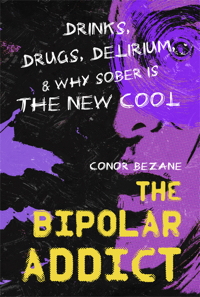Say you’re dating a new guy or girl. It’s going really well. After a few weeks, you’re finally ready to disclose your illness to that person. But bipolar is shrouded in mystery for them. Well, The Bipolar Addict’s got you covered. Have them read this easy guide to all things bipolar. Or, if you are or think you are one of us, use this article to brush up on the facts.

An Overview
Bipolar disorder, formerly called manic depression, occurs when a person experiences mania – an elevated mood marked by increased energy, delusions of grandeur, and sometimes psychosis, paranoia, and hallucinations. Mania is a perpetual high that feels like doing cocaine without actually snorting it. Those who struggle with this malady are also plagued with bouts of horrible depression, resulting in intense mood swings (thus the term bipolar). With proper medication and therapy, symptoms can be managed. Bipolar disorder is genetic.
How Many People Have it?
There are 5.7 million Americans with bipolar disorder, according to the Depression and Bipolar Support Alliance. Sixty percent of us are addicts, says the Epidemiologic Catchment Study.
Bipolar and Addiction Go Hand in Hand
The disease is especially difficult to diagnose when addiction is involved. This is because the symptoms of bipolar often mimic the behaviors of those abusing drugs and alcohol. If you’re high, you might exhibit manic behaviors. If you’re depressed, it might be because you are drinking to excess (alcohol is a depressant).
The Two Types of Bipolar
Bipolar 1 is the more extreme of the two and can feature psychosis and hallucinations in addition to insane, full-blown mania and crippling depression. In my case, I had serious hallucinations. I thought I was on reality TV and that there were cameras in my apartment watching my every move. I was seeing purple everywhere I looked, not knowing it was a coincidence. I went on shopping sprees I couldn’t afford.
And then there’s bipolar 2. Those who have this less severe version do not experience full-blown mania but do feel hypomania, which is a period of intense happiness without the hallucinations or psychosis.
Those with bipolar 2 may experience rapid cycling, or symptoms quickly flipping over in a matter of days, weeks or a few months. They are more likely to lean on the depressive end of the spectrum, having less frequent periods of normality.
Creativity
Bipolar people tend to be creative in some way. Edgar Allen Poe, Vincent Van Gogh, and Virginia Woolf were all bipolar addicts. Modern people who have or had the disease include Kurt Cobain, Robin Williams, Amy Winehouse, Catherine Zeta-Jones, and Carrie Fisher, who played Princess Leia in the Star Wars films.
How Is It Treated?
Bipolar is treated with psychotherapy and medication. Lithium, a salt that occurs in nature, was the first drug to be introduced to treat bipolar. It was approved by the FDA in 1970 and is still used widely today. Those who are bipolar are often on complex medication regimens. Antidepressants such as Prozac and Paxil treat the depressive side of the disease and can only be taken with a mood stabilizer such as Lamictal or Depakote. Without a mood stabilizer, antidepressants trigger mania. To treat mania and psychosis, doctors use antipsychotics such as Geodon and Seroquel.
Can Bipolar Disorder Be Cured?
No. Bipolar is a chronic disease. Like diabetes, symptoms can only be managed. But with medications and therapy, many afflicted individuals can live near-normal, productive lives.







